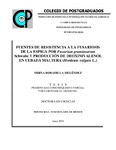| dc.contributor.author | Bobadilla Meléndez, Mirna | |
| dc.creator | BOBADILLA MELENDEZ, MIRNA; 317692 | |
| dc.date.accessioned | 2018-10-29T17:17:16Z | |
| dc.date.available | 2018-10-29T17:17:16Z | |
| dc.date.issued | 2018 | |
| dc.identifier.uri | http://hdl.handle.net/10521/3039 | |
| dc.description | Tesis (Doctorado en Ciencias, especialista en Fitopatología).- Colegio de Postgraduados, 2018 | es_MX |
| dc.description.abstract | La fusariosis de la espiga por Fusarium graminearum Schwabe (teleomorfo Gibberella zeae (Schweimitz) es una enfermedad devastadora de la cebada a nivel internacional. La enfermedad afecta no solo el rendimiento sino también la calidad del grano por la producción de deoxinivalenol (DON), compuesto tóxico del grupo de los tricotecenos, que daña la salud de personas y animales que consumen granos contaminados. Entre las medidas de control se encuentra el uso de variedades resistentes por lo que este trabajo tuvo como objetivo general evaluar la resistencia a la fusariosis y a la acumulación de DON en 131 líneas avanzadas de cebada maltera seleccionadas por su tolerancia a roya lineal amarilla, roya de la hoja, mancha reticulada, tizón foliar y escaldadura de la hoja, del programa de Cebada del INIFAP-CEVAMEX. Durante tres años las líneas 30, 47, 65 y 123, así como las líneas 73, 91 y 96, de seis y dos hileras de grano, respectivamente, registraron síntomas muy bajos de fusariosis en respuesta a la inoculación con F. graminearum en pruebas en invernadero. Aunque la severidad de la enfermedad no se relacionó (r = 0.5682) con la acumulación de DON, estas líneas registraron muy baja o nula producción de toxina cuando se analizaron con la prueba RIDASCREEN® FAST DON de ELISA. La información generada en este estudio es relevante ya que indica que estas líneas resistentes a la enfermedad y a la acumulación de DON tienen potencial para utilizarse como fuentes de resistencia en un programa de cruzamientos en cebada maltera que incluya en el conjunto de enfermedades a la fusariosis de la espiga. _______________ RESISTANCE SOURCES TO Fusarium head blight BY Fusarium graminearum Schwabe AND DEOXYNIVALENOL PRODUCTION IN MALTING BARLEY ADVANCED LINES (Hordeum vulgare L.). ABSTRACT: Fusarium head blight (FHB) caused by Fusarium graminearum Schwabe (telomorph Gibberella zeae (Schweimitz)) is a devastating disease in many barley production areas throughout the world. This disease affects not only the yield but also the quality of the grain due to the production of deoxynivalenol (DON), a toxic compound of the trichothecene group, that is harmful to human and animals that consume contaminated grain with the fungus. The use of resistant varieties, among others control measures, is very important, so this work had as a general objective to evaluate the resistance to FHB and the accumulation of DON in 131 malting barley advanced lines, selected for their tolerance to yellow rust, leaf rust, net blotch, leaf blight and leaf scald, of the INIFAP-CEVAMEX barley program. For three years the advanced lines 30, 47, 65 and 123, as well as lines 73, 91 and 96, six and two rows lines, respectively, registered very low symptoms of FHB in response to inoculation with F. graminearum in greenhouse tests. Although the severity of the disease was not related (r = 0.5682) to the accumulation of DON, these lines registered very low or no toxin production when analyzed with the RIDASCREEN® FAST DON ELISA test. The information generated in this study is relevant since it indicates that these resistant lines to FHB and DON accumulation have the potential to be considered as sources of resistance to FHB in a crossbreeding program in malting barley. | es_MX |
| dc.description.sponsorship | Consejo Nacional de Ciencia y Tecnología (CONACyT). | es_MX |
| dc.format | pdf | es_MX |
| dc.language.iso | spa | es_MX |
| dc.rights.uri | http://creativecommons.org/licenses/by-nc-nd/4.0 | es_MX |
| dc.subject | Fusarium graminearum | es_MX |
| dc.subject | Hordeum vulgare | es_MX |
| dc.subject | Resistencia | es_MX |
| dc.subject | Deoxinivalenol | es_MX |
| dc.subject | Resistance | es_MX |
| dc.subject | Fitopatología | es_MX |
| dc.subject | Doctorado | es_MX |
| dc.subject.classification | CIENCIAS AGROPECUARIAS Y BIOTECNOLOGÍA::CIENCIAS AGRARIAS::FITOPATOLOGÍA::FITOPATOLOGÍA | es_MX |
| dc.title | Fuentes de resistencia a la fusariosis de la espiga por Fusarium graminearum Schwabe y producción de deoxinivalenol en cebada maltera (Hordeum vulgare L) | es_MX |
| dc.type | Tesis | es_MX |
| Tesis.contributor.advisor | Hernández Anguiano, Ana María | |
| Tesis.contributor.advisor | Zamora Díaz, Mauro Refugio | |
| Tesis.contributor.advisor | Kumar Singh, Pawan | |
| Tesis.contributor.advisor | Vargas Hernández, Mateo | |
| Tesis.contributor.advisor | Mezzalama, Mónica | |
| Tesis.date.submitted | 2018 | |
| Tesis.date.accesioned | 2018 | |
| Tesis.date.available | 2018 | |
| Tesis.format.mimetype | pdf | es_MX |
| Tesis.format.extent | 2,908 KB | es_MX |
| Tesis.subject.nal | Fusariosis de la espiga | es_MX |
| Tesis.subject.nal | Fusarium head blight | es_MX |
| Tesis.subject.nal | Hordeum vulgare | es_MX |
| Tesis.subject.nal | Deoxinivalenol | es_MX |
| Tesis.subject.nal | Ensayos de variedades | es_MX |
| Tesis.subject.nal | Variety trials | es_MX |
| Tesis.subject.nal | Resistencia a la enfermedad | es_MX |
| Tesis.subject.nal | Disease resistance | es_MX |
| Tesis.subject.nal | México | es_MX |
| Tesis.rights | Acceso abierto | es_MX |
| Articulos.subject.classification | Cebada-rendimiento | es_MX |
| dc.type.conacyt | doctoralThesis | es_MX |
| dc.identificator | 6||31||3108||241709 | es_MX |
| dc.contributor.director | HERNANDEZ ANGUIANO, ANA MARIA; 54001 | |
| dc.audience | generalPublic | es_MX |


